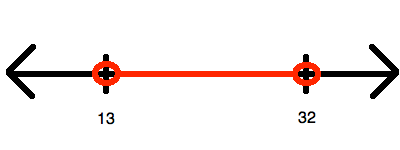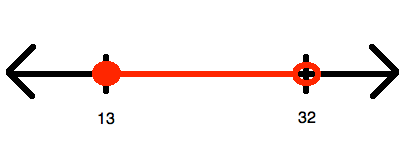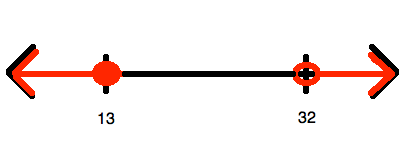All PSAT Math Resources
Example Questions
Example Question #21 : Absolute Value
If 

Substitute – 4 in for x. Remember that when a negative number is raised to the third power, it is negative. - = – 64. – 64 – 36 = – 100. Since you are asked to take the absolute value of – 100 the final value of f(-4) = 100. The absolute value of any number is positive.
Example Question #1 : Integers
For which of the following functions below does f(x) = |f(x)| for every value of x within its domain?
f(x) = x4 + x
f(x) = 2x + 3
f(x) = x4 + (1 – x)2
f(x) = x2 – 9
f(x) = x2 – 2x
f(x) = x4 + (1 – x)2
When we take the absolute value of a function, any negative values get changed into positive values. Essentially, |f(x)| will take all of the negative values of f(x) and reflect them across the x-axis. However, any values of f(x) that are positive or equal to zero will not be changed, because the absolute value of a positive number (or zero) is still the same number.
If we can show that f(x) has negative values, then |f(x)| will be different from f(x) at some points, because its negative values will be changed to positive values. In other words, our answer will consist of the function that never has negative values.
Let's look at f(x) = 2x + 3. Obviously, this equation of a line will have negative values. For example, where x = –4, f(–4) = 2(–4) + 3 = –5, which is negative. Thus, f(x) has negative values, and if we were to graph |f(x)|, the result would be different from f(x). Therefore, f(x) = 2x + 3 isn't the correct answer.
Next, let's look at f(x) = x2 – 9. If we let x = 1, then f(1) = 1 – 9 = –8, which is negative. Thus |f(x)| will not be the same as f(x), and we can eliminate this choice as well.
Now, let's examine f(x) = x2 – 2x. We know that x2 by itself can never be negative. However, if x2 is really small, then adding –2x could make it negative. Therefore, let's evaluate f(x) when x is a fractional value such as 1/2. f(1/2) = 1/4 – 1 = –3/4, which is negative. Thus, there are some values on f(x) that are negative, so we can eliminate this function.
Next, let's examine f(x) = x4 + x. In general, any number taken to an even-numbered power must always be non-negative. Therefore, x4 cannot be negative, because if we multiplied a negative number by itself four times, the result would be positive. However, the x term could be negative. If we let x be a small negative fraction, then x4 would be close to zero, and we would be left with x, which is negative. For example, let's find f(x) when x = –1/2. f(–1/2) = (–1/2)4 + (–1/2) = (1/16) – (1/2) = –7/16, which is negative. Thus, |f(x)| is not always the same as f(x).
By process of elimination, the answer is f(x) = x4 + (1 – x)2 . This makes sense because x4 can't be negative, and because (1 – x)2 can't be negative. No matter what we subtract from one, when we square the final result, we can't get a negative number. And if we add x4 and (1 – x)2, the result will also be non-negative, because adding two non-negative numbers always produces a non-negative result. Therefore, f(x) = x4 + (1 – x)2 will not have any negative values, and |f(x)| will be the same as f(x) for all values of x.
The answer is f(x) = x4 + (1 – x)2 .
Example Question #1771 : Psat Mathematics
Let 




We need to solve the two equations |2a – 3| = 5 and |3 – 4b| = 11, in order to determine the possible values of a and b. When solving equations involving absolute values, we must remember to consider both the positive and negative cases. For example, if |x| = 4, then x can be either 4 or –4.
Let's look at |2a – 3| = 5. The two equations we need to solve are 2a – 3 = 5 and 2a – 3 = –5.
2a – 3 = 5 or 2a – 3 = –5
Add 3 to both sides.
2a = 8 or 2a = –2
Divide by 2.
a = 4 or a = –1
Therefore, the two possible values for a are 4 and –1. However, the problem states that both a and b are negative. Thus, a must equal –1.
Let's now find the values of b.
3 – 4b = 11 or 3 – 4b = –11
Subtract 3 from both sides.
–4b = 8 or –4b = –14
Divide by –4.
b = –2 or b = 7/2
Since b must also be negative, b must equal –2.
We have determined that a is –1 and b is –2. The original question asks us to find |b – a|.
|b – a| = |–2 – (–1)| = | –2 + 1 | = |–1| = 1.
The answer is 1.
Example Question #3 : Integers
Evaluate 

Remember that the absolute value of a number is the positive value of that number. It is important to know what absolute value represents: the distance of any given number from the number 0. For that reason, absolute value cannot be negative, and we can eliminate 

To solve, substitute 
The answer is 12.
Example Question #2 : Integers
Example Question #5 : Integers
How many of these statements are correct?
I)
II)
III)
IV)
Two
Four
None
Three
One
Two
The absolute value of a nonnegative number is the number itself; the absolute value of a negative number can be obtained by removing the negative symbol. Therefore,

The four statements can be rewritten as:
Both I and III) 
Both II and IV) 
The correct response is two.
Example Question #3 : Integers
If 0 < n < 1, then which of the following is the smallest?
1/n2
–1/n3
n2
–1/n
n3 – 1
–1/n3
First, it will help us to determine which of the answer choices are positive and which are negative.
Because n is positive, we know that n2 is positive, because any number squared is positive. Similarly, 1/n2 is also positive.
Let's look at the answer choice –1/n. This must be negative, because a negative number divided by a positive one will give us a negative number. Similarly, –1/n3 will also be negative.
The last choice is n3 – 1. We are told that 0 < n < 1. Because n is a positive value less than one, we know that 0 < n3 < n2 < n < 1. In other words, n3 will be a small positive value, but it will still be less than one. Thus, because n3 < 1, if we subtract 1 from both sides, we see that n3 – 1 < 0. Therefore, n3 - 1 is a negative value.
All negative numbers are less than positive numbers. Thus, we can eliminate n2 and 1/n2, which are both positive. We are left with –1/n, –1/n3, and n3 – 1.
Let us compare –1/n and –1/n3. First, let us assume that –1/n < –1/n3.
–1/n < –1/n3
Multiply both sides by n3. We don't need to switch the signs because n3 is positive.
–n2 < –1
Multiply both sides by –1.
n2 > 1.
We know that n2 will only be bigger than 1 when n > 1 or if n < –1. But we know that 0 < n < 1, so –1/n is not less than –1/n3. Therefore, –1/n3 must be smaller.
Finally, let's compare –1/n3 and n3 – 1. Let us assume that –1/n3 < n3 – 1.
–1/n3 < n3 – 1
Multiply both sides by n3.
–1 < n6 – n3
Add one to both sides.
n6 – n3 + 1 > 0. If this inequality is true, then it will be true that –1/n3 is the smallest number.
Here it will be helpful to try some values for n. Let's pick n = 1/2 and see what happens. It will help to use our calculator.
(1/2)6 – (1/2)3 + 1 = 0.891 > 0.
Therefore, we suspect that because n6 – n3 + 1 > 0, –1/n3 is indeed the smallest number. We can verify this by trying more values of n.
The answer is –1/n3.
Example Question #2 : Number Lines And Absolute Value
What property of arithmetic is demonstrated here?
If 


Inverse
Associative
Transitive
Symmetric
Commutative
Transitive
The symbols express the idea that if a number is less than a second number, which is less than a third, then the first number is less than the third. This is the transitive property of inequality.
Example Question #51 : Integers
On a real number line, x1 = -4 and x2 = 14. What is the distance between these two points?
4
18
-18
10
18
The distance between two points is always positive. We calculate lx2 - x1l, which will give us the distance between the points.
|14- (-4)| = |14+4| = |18| = 18
Example Question #51 : Integers
Which of the following is a graph for the values of 






To begin, you must simplify so that you "isolate" 

Now, this inequality represents all of the numbers between 13 and 32. However, it does include 


Certified Tutor
All PSAT Math Resources








































